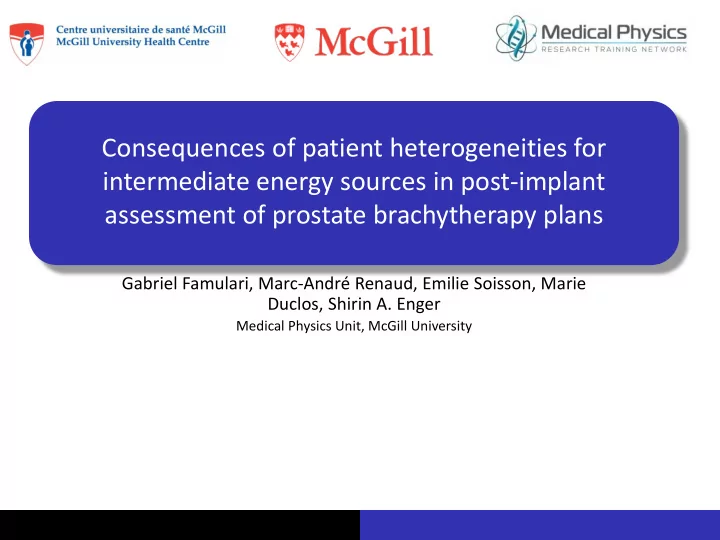

Consequences of patient heterogeneities for intermediate energy sources in post-implant assessment of prostate brachytherapy plans Gabriel Famulari, Marc-André Renaud, Emilie Soisson, Marie Duclos, Shirin A. Enger Medical Physics Unit, McGill University
Heterogeneity corrections Model-based dose calculation algorithms (MBDCA) are commercially available for brachytherapy dosimetry: MC GBBS (ACUROS BV, Varian) CCC (ACE, Elekta) Peppa et al., 2016 MBDCA account for: Lemaréchal et al., 2015 • Tissue heterogeneities • Interseed attenuation • Applicator heterogeneities (high-Z shielding) 2017-10-16 Gabriel Famulari Introduction 2
Alternative HDR sources Brachytherapy can be administered by: low energy sources ( E < 50 keV) -> LDR intermediate energy sources (50 keV < E < 200 keV) high energy sources ( E > 200 keV) -> HDR Recently, sources in the high ( 60 Co, 75 Se) and intermediate ( 169 Yb, 153 Gd) energy range have been proposed as alternatives to 192 Ir for HDR BT Tissue composition and heterogeneities ignored -> errors in dosimetric indices 60 Co 192 Ir 75 Se 169 Yb 153 Gd 𝛾 - 𝛾 -, IC 𝛾 - 𝛾 - 𝛾 - Decay mode Half-life (days) 1925 73.8 119.8 32.0 240.4 Mean 𝛿 energy (keV) 1250 360 210 93 60 HVL (mm Pb) 11 3 0.7 0.2 0.08 Activity to obtain 𝐸 (r 0 , 𝜄 0 ) 3.1 10 - 3.1 180 Α (Ci) Aim: Determine the impact of tissue heterogeneities for alternative sources. 2017-10-16 Gabriel Famulari Introduction 3
Materials and Methods 5 prostate HDR BT cases Geant4-based MC dose calculation engine - Simulates nuclear decay - Accounts for density and material composition of tissues, applicators, sources OUTPUT: DICOM-RT - Track length estimator - D w,w - Variable scoring mesh (CT, RS, RP, RD) - D m,m Column generation based optimizer 2017-10-16 Gabriel Famulari Materials and Methods 4
Source characteristics Increased contribution from multiple scattered photons 93 keV 210 keV 60 keV 380 keV 1.25 MeV 2017-10-16 Gabriel Famulari Results 5
Prostate case Advantages of intermediate energy sources: Optimal depth dose profiles (better target homogeneity) Reduced shielding requirements Suitable to deliver intensity modulated brachytherapy (IMBT) 2017-10-16 Gabriel Famulari Results 6
Dosimetric impact (b) 153 Gd (a) 192 Ir 2017-10-16 Gabriel Famulari Results 7
Dosimetric impact Small impact on prescription dose D 90 PTV D 10 Urethra Reduction in urethral dose by 1-6% 2017-10-16 Gabriel Famulari Results 8
Dosimetric impact Reduction in dose to bladder and rectum by 1-4% D 2cc Rectum D 2cc Bladder 2017-10-16 Gabriel Famulari Results 9
Conclusions Intermediate energy sources have the potential to increase dose homogeneity within the PTV while limiting hot spots in the bladder, rectum and urethra. The ignorance of soft tissue heterogeneities resulted in overestimation of the dose delivered to OARs and underestimation of dose to bone. Especially true for intermediate energy sources. There is still debate on whether differences are significant or not compared to other uncertainties in brachytherapy. Dose delivery accuracy within ~5% (k=1) Includes source-to-detector position, material composition, TPS, source specs Intermediate energy sources have yet to be introduced in the clinic… … there is still time to implement and validate MBDCAs for intermediate energies. 2017-10-16 Gabriel Famulari Conclusions 10
Acknowledgements Special thanks: Dr. Shirin Enger Marc-André Renaud Dr. Emilie Soisson Dr. Marie Duclos Dr. Jan Seuntjens MPU students and staff The authors acknowledge partial support by the CREATE Medical Physics Research Training grant of the Natural Sciences and Engineering Research Council (grant number: 432290) 2017-10-16 Gabriel Famulari Acknowledgements 11
Recommend
More recommend